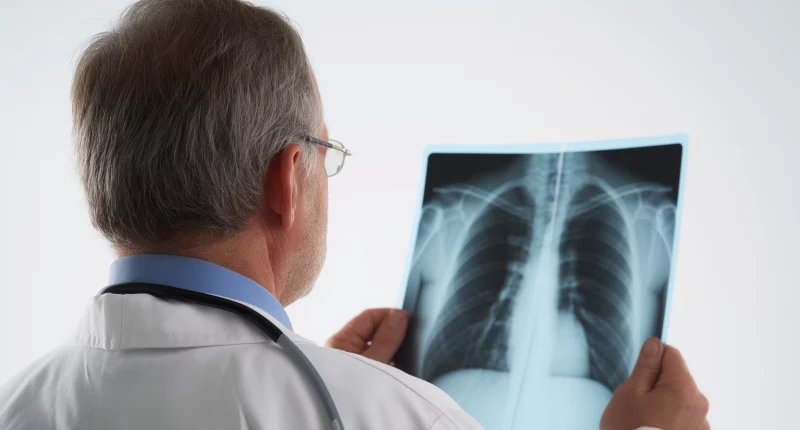Pneumonia
What’s that?
Pneumonia is an acute infectious and inflammatory disease of the lungs caused by bacteria, viruses, protozoa or fungal spores. It can occur as an independent pathology or complicate the course of other health problems (influenza, immunodeficiencies, acute inflammatory processes of any localization, neoplasms and others). Significantly reduces the quality of life of a person and in the absence of timely treatment can lead to a number of serious complications.
About the disease
In pneumonia in the inflammatory process involves most of the alveoli and interstitium of the lungs, which is accompanied by the release of a large amount of inflammatory fluid into the cavity of the alveoli and is manifested by a characteristic clinical and radiological picture.
It is a common pathology – it affects from 10 to 17 people per thousand population in different age groups. Pneumonia of the lungs is the most dangerous for children under a year old and the elderly – more often leads to complications and in almost 10% of cases – to death.
Classification of pneumonias
Depending on the conditions of infection, a distinction is made:
- community-acquired pneumonia (develops outside of a medical facility or within 2 days of hospitalization);
- nosocomial (occurs in conditions of prolonged stay in hospital; associated with nosocomial microbial flora, is more severe and more difficult to treat);
- ventilator-associated (diagnosed in people who are on artificial ventilation);
- aspirational (caused by food, liquid or chemicals entering the airways);
- atypical pneumonia (it is caused by atypical pathogens – mycoplasmas, chlamydia and others).
Depending on the causative factor distinguished:
- bacterial;
- viral;
- fungal;
- caused by protozoa (most commonly mycoplasma);
- mixed-flora pneumonia.
In addition, there are types of pneumonia such as:
- one- or two-sided;
- segmental, polysegmental, lobular, lobular, subtotal, total;
- acute or protracted;
- accompanied by functional lung disorders or without them;
- complicated and uncomplicated;
- mild, moderate, and severe.
Symptoms of pneumonia
The symptoms of pneumonia vary depending on the type of disease, its severity and a number of other factors. With primary bacterial infection, the disease develops rapidly. A healthy person’s body temperature rises sharply, wet cough and shortness of breath appear as a result of direct damage to the lung tissue by bacteria.
Viral, including coronavirus, pneumonia in adults develops gradually, in several stages, each of which is accompanied by appropriate symptoms. The pathogen gradually descends from the upper respiratory tract to the alveolocytes, damaging them. The human immune system at this time actively fights the virus.
Symptoms of lung inflammation are nonspecific and can vary in intensity. They are:
- pain in his side when he takes a deep breath;
- shortness of breath and sweating with minimal physical activity;
- cough with sputum of mucous or mucopurulent character;
- weakness and increased fatigue;
- headache;
- elevated body temperature;
If you do not diagnose pneumonia in time, the disease gradually progresses, affects a larger volume of lungs, leads to the development of complications.
Bacteria that enter the bloodstream from the affected lungs can be carried throughout the body, disrupting the function of other organs. If pus collects in the airways, an abscess or purulent pleurisy develops. In some cases, surgery or drainage may be needed to drain the pus from the respiratory system.
Complications of pneumonia
Typical complications of pneumonia include:
- scarring of the lung tissue;
- acute respiratory failure;
- purulent pleurisy;
- abscess or gangrene of the lung;
- septic shock;
- meningitis;
The most frequent complications of out-of-hospital pneumonia include the development of severe bronchoobstructive syndrome, which is manifested by narrowing of the airways and is characterized by:
- wheezing in the chest;
- increased shortness of breath;
- development of difficulty breathing and poor expectoration of sputum.
Less common are complications such as pleurisy, when inflammatory fluid enters the pleural cavity surrounding the lungs and squeezes them from the outside. In this case, the patient on the affected side may have chest pain when breathing, increased or shortness of breath, a sharp rise in temperature.
Causes of pneumonia
Pneumonia is an infectious disease that can be caused by viruses (adenovirus, coronavirus), bacteria (especially Streptococcus pneumoniae), fungi (genus candida, aspergillus) or protozoa (mycoplasmas, chlamydia). Infection occurs more often by airborne or household contact, less often the pathogen enters the alveoli with the blood or lymphatic flow against the background of other inflammatory processes in the body.
In most cases, pneumonia begins after hypothermia on the background of respiratory viral infection. As the disease develops, the infectious agent spreads into the lower respiratory tract to the alveoli. But not always pathogens provoke pneumonia. Lung inflammation is affected by a combination of factors: human immunity, chronic diseases, age, bad habits, properly selected treatment.
Also risk factors for pneumonia include:
- frequent acute respiratory infections and flu;
- bad habits (they weaken the immune system);
- constant stress and overwork;
- vitamin and mineral deficiencies;
- Age over 65 to 70 years old;
- living in areas with air pollution.
Diagnosis of pneumonia
The most important thing for a patient with suspected pneumonia is to go to a medical institution as early as possible. Doctors are tasked with making a correct diagnosis and selecting an effective treatment.
First of all, the therapist or pulmonologist carefully talks to the patient, clarifying complaints, collecting a history of life and the disease. Then he conducts an objective examination: examines the patient, feels, taps his chest, conducts auscultation of the lungs. In this way, he is able to detect objective signs of pneumonia, so that on the basis of these data to recommend the patient further examination.
An essential part of the process of diagnosing pneumonia is determining the type of pathogen.
A patient with suspected pathology may be prescribed:
- general blood test
- biochemical analysis of blood (coagulogram, determination of the level of C-reactive protein, liver and kidney function indicators);
- sowing of sputum or bronchial flush on nutrient medium with determination of sensitivity of flora to antimicrobials);
- pulse oximetry;
- lung X-rays;
- chest CT scan;
In the process of diagnosis, the pulmonologist must exclude other, similar in symptomatology, diseases: tuberculosis, oncologic pathology, pulmonary embolism.
Treatment
In the treatment of acute pneumonia, pulmonologists adhere to an individual approach to each patient, taking into account international recommendations for the therapy of this pathology. The duration of treatment depends on the type of disease, severity of its course and other factors. Patients with severe forms of pathology are subject to hospitalization in hospital.
Treatment of pneumonia in adults and children begins immediately after diagnosis. It is based on antibiotics. Choosing antibacterial drugs, the specialist assesses the severity of pneumonia, the total bacterial load, the presence of concomitant pathology, contraindications to the active substance and the patient’s allergic history. At the beginning of therapy, the patient is prescribed drugs of the widest possible spectrum of action, taking into account the possible causative agent of the disease. After the pathogen is verified in the laboratory, it is possible to correct the therapy – replacement of the antibacterial drug with a more effective in this case.
The patient may also be prescribed antipyretics, expectorants, immunomodulators, immunoglobulins, glucocorticosteroids.
In some severe cases, patients may need an extracorporeal membrane oxygenation (ECMO) machine to help the body cope with the effects of pneumonia.
All these treatment options are available in more than 600 hospitals worldwide (https://doctor.global/results/diseases/pneumonia). For example, Extracorporeal membrane oxygenation (ECMO) can be performed in 15 clinics across Germany (https://doctor.global/results/europe/germany/all-cities/all-specializations/procedures/extracorporeal-membrane-oxygenation-ecmo).
Prevention of pneumonia
Today there is an effective method of specific prevention of pneumococcal pneumonia – vaccination. Pneumococcal vaccine is well tolerated by adults and adolescents from 16 years of age, does not cause complications and exacerbation of chronic diseases, provides reliable protection against infection.
Nonspecific preventive measures:
- healthy lifestyle (walks in the fresh air, observance of work and rest regime, quality sleep, balanced nutrition);
- timely treatment of acute respiratory viral infections and bacterial infections.
Patients from the risk group (age 65+, presence of chronic diseases) should be especially attentive to their body.
Rehabilitation
The recovery process after pneumonia is long – up to a month. The main indicator of cure is the normalization of well-being, general condition of the patient, positive dynamics of examination results. Sometimes the picture of recovery does not agree with the radiographic data. This means that the process of regeneration of the lung parenchyma is not yet complete. Full recovery of respiratory function can take up to six months.



